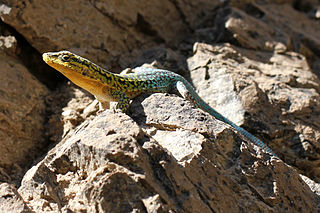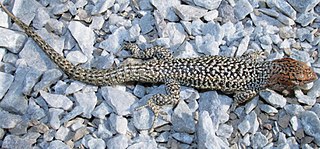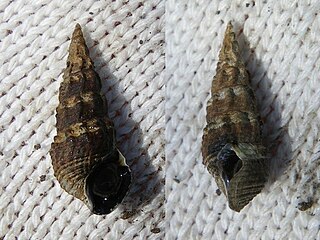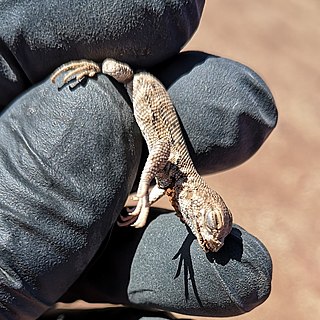
Liolaemidae are a family of iguanian lizards. They were traditionally included in the family Iguanidae as subfamily Liolaeminae, which some more recent authors prefer to delimit in a more restricted way. A common name for this group is liolaemids. Liolaemidae are typically herbivores that have a diet high in fruit. Because of this special diet, Liolaemidae have a larger small intestine when compared to other similar omnivorous and insectivorous lizards.

Liolaemus is a genus of iguanian lizards, containing many species, all of which are endemic to South America.

Liolaemus constanzae, commonly known as Constanza's tree iguana, is a species of lizard in the family Liolaemidae. The species is endemic to South America.
Liolaemus lutzae, called commonly Lutz's tree iguana, is a species of lizard in the family Liolaemidae. The species is endemic to Brazil.

Batillaria is a genus of small salt marsh or mudflat snails, marine gastropod mollusks in the family Batillariidae, the horn snails.

The Chilean Matorral (NT1201) is a terrestrial ecoregion of central Chile, located on the west coast of South America. It is in the Mediterranean forests, woodlands, and scrub biome, part of the Neotropical realm.

Franz Martin Hilgendorf was a German zoologist and paleontologist. Hilgendorf's research on fossil snails from the Steinheim crater in the early 1860s became a palaeontological evidence for the theory of evolution published by Charles Darwin in 1859.

Batillaria multiformis is a species of sea snail, a marine gastropod mollusk in the family Batillariidae.
Merimnetria multiformis is a moth of the family Gelechiidae. It was first described by Edward Meyrick in 1928. It is endemic to the Hawaiian island of Oahu and possibly Hawaii.

Liolaemus chiliensis is a species of lizard in the family Liolaemidae, also referred to as the weeping or crying lizard in English. Synonyms for this species include Liodeira chilensis and Calotes chiliensis. Less commonly, it is called the Talcahuano Smooth-throated Lizard.

Liolaemus fabiani, also known commonly as Fabian's lizard, Yanez's tree iguana, and lagartija de Fabián in Spanish, is a species of lizard in the family Liolaemidae. The species is native to Chile.

Oliver Payne Pearson, or "Paynie" to many that knew him, was an American zoologist and ecologist. Over a very active 50-year career, he served as professor of zoology at UC Berkeley and curator of mammals at the Museum of Vertebrate Zoology. Pearson is best known for his work on the role of predation on vole demography and population cycles, and for his piercing contributions to the biology of South American mammals, but his earlier studies on reproductive and physiological ecology are highly regarded as well.

Liolaemus stolzmanni, commonly known as Stolzmann's Pacific iguana, is a species of lizard in the family Liolaemidae.
Rubus multiformis is an uncommon North American species of flowering plant in the rose family. It is found in eastern Canada and the northeastern and north-central United States.
Pluriformea is a proposed sibling clade of the Filozoa, and consists of Syssomonas multiformis and the Corallochytrea. Together with the Ichthyosporea they form the Holozoa.
The Upper Bedoulian Formation is a geological formation in the Murcia Region, Spain whose strata date back to the Early Cretaceous. The marls were deposited in an open marine environment. The lower unit is marly with iron concretions and septaria.

Roberto Donoso-Barros was a Chilean zoologist, naturalist, and herpetologist.

Liolaemus sarmientoi is a species of lizard in the family Liolaemidae. It is considered a medium-sized example of the family, with an average snout–vent length of 76 to 77 mm, with males usually larger than females.
Liolaemus scapularis, the shoulder tree iguana, is a species of lizard in the family Iguanidae. It is from Argentina.












